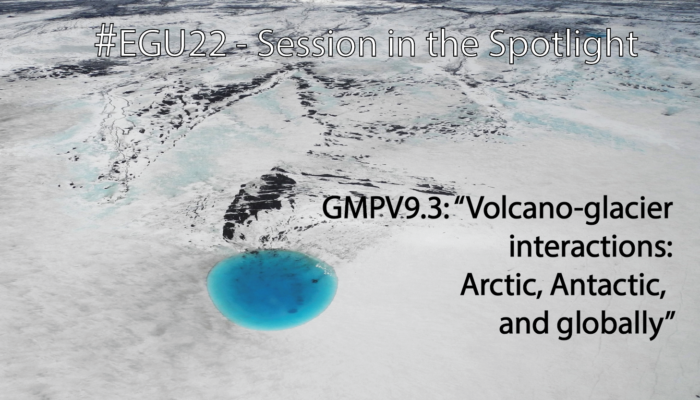
The #EGU22 abstract submission is almost here – less than a week until it closes on January 12th at 13:00 CET. So it is time to wrap up our sessions in the spotlight with a last highlight – the interdisciplianry session GMPV9.3 “Volcano-glacier interactions: Arctic, Antarctic, and globally“. This session is organized by a diverse team consisting of Eva Eibl, Iestyn Barr, Adelina Geyer and Gioachino Roberti. So if you are interested in volcano-glacier interactions you should give it a close look!
The conveners say:
Volcanic activity and geothermal heating can lead to depressions on the ice surface in which water can accumulate (see photo from Vatnajökull glacier, Iceland). This 700m wide and 30m deep depression, called an ‘ice cauldron’, is surrounded by circular crevasses on the ice surface and is located on the glacier tongue Dyngjujökull, an outlet glacier of Vatnajökull. The photo was taken on 4 June 2016, less than 22 months after the Holuhraun eruption, which started on 29 August 2014 in the flood plain north of the Dyngjujökull glacier and this depression. It is most likely a sign of a subglacial eruption where ice was molten at the base of the glacier while volcanic material was deposited constrained by a several meter thick ice layer. The glacier load might have also influenced the eruptive activity and the dike that migrated laterally for nearly 50km at more than 4 km depth. If this eruption had continued tephra might have been deposited on the surface of the glacier changing its dynamics or mass balance.Glaciovolcanoes also frequently preserve a remarkable, and in many ways unique, record of the eruptive environment, whether glacial or non-glacial, that is capable of significantly advancing our knowledge of how Earth’s climate system evolves. While this has been investigated particularly in Antarctica and British Columbia, other regions with glaciovolcanoes have yet to enter into this debate significantly.We welcome contributions from any part of the world that address climate and environmental change through glaciovolcanic studies.We invite contributions that deal with the mitigation of the hazards such as lava flows, volcanic ash, lahars, landslides, pyroclastic flows and outburst floods associated with ice-covered volcanoes in the Arctic, Antarctic or globally. We are looking for studies that improve the understanding of signals generated by ice-covered volcanoes, or studies focused on volcanic impacts on glaciers and vice versa. Research on recent activity is especially welcomed. This includes geological observations e.g. of deposits in the field or remote-sensing data, together with experimental and modelling approaches. We also invite contributions on past activity and glaciovolcanic deposits. We aim to bring together scientists from volcanology, glaciology, seismology, geodesy, hydrology, geomorphology and atmospheric science in order to enable a broad discussion and interaction.
If this is the session you want to submit your abstract to, you can do so here!

